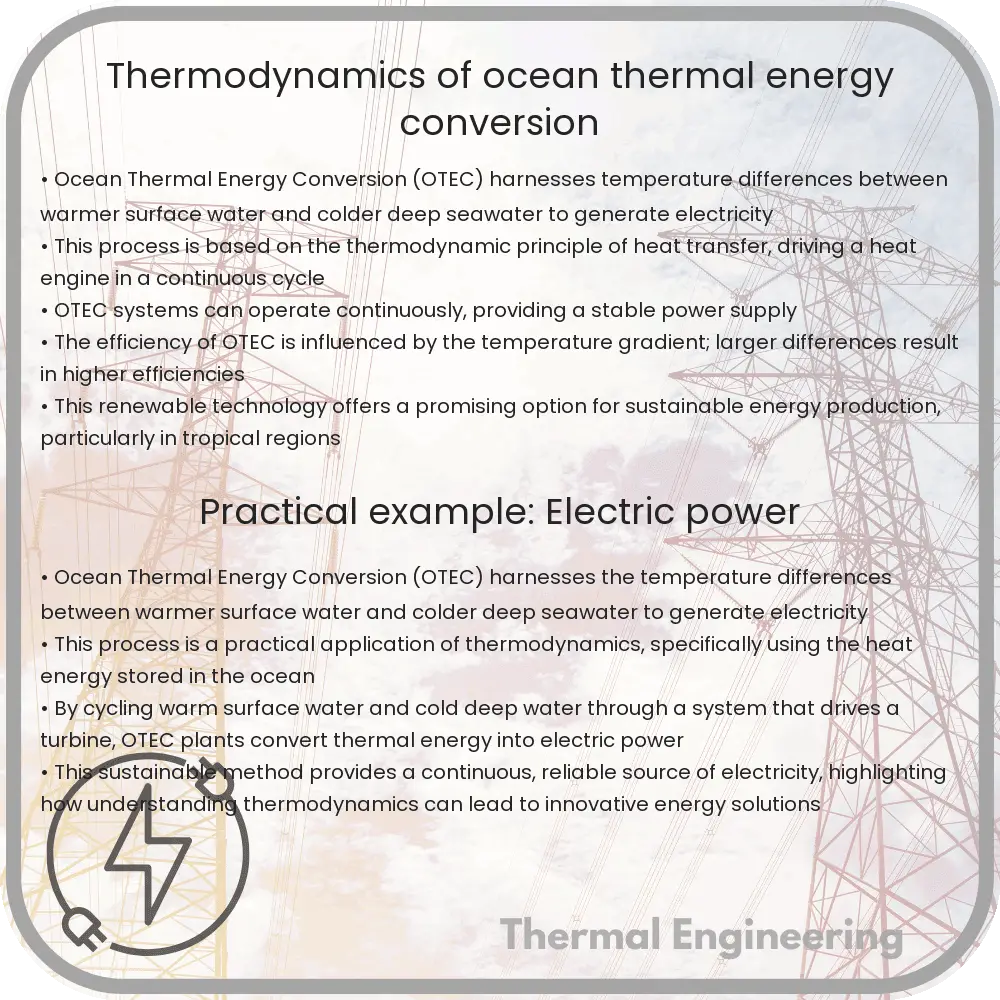Learn how Ocean Thermal Energy Conversion (OTEC) utilizes the temperature difference between surface and deep seawater to generate sustainable energy.

Understanding the Thermodynamics of Ocean Thermal Energy Conversion
Ocean Thermal Energy Conversion (OTEC) is a process that can generate electricity by using the temperature difference between deep cold and warm surface seawater. This innovative approach taps into the vast solar energy absorbed by the ocean’s surface, offering a sustainable solution to part of the global energy needs. Here, we will explore the basic thermodynamic principles that underpin OTEC systems.
Basic Principle of OTEC
OTEC systems operate based on the thermodynamic cycle, primarily using the Rankine cycle, which is a common method in thermal power generation. The key to OTEC’s operation lies in the temperature difference between the warmer surface water and the colder deep-sea water. This temperature gradient can be utilized to run a heat engine, which in turn, drives a generator to produce electricity.
The Rankine Cycle in OTEC
The Rankine cycle involves several steps integrating both the warm surface water and the cold deep-sea water:
- Evaporation: Warm surface seawater is used to heat a working fluid, which is typically a low-boiling-point substance such as ammonia or propane. This causes the fluid to vaporize at high pressure.
- Turbine Work: The high-pressure vapors then expand through a turbine, spinning it, which in turn spins a generator to produce electricity.
- Condensation: The vapor exits the turbine at a lower pressure and must be cooled so that it can condense back into a liquid. Cold seawater pumped from the ocean’s depths is used to achieve this condensation.
- Pumping: Finally, pumps are used to move the condensed fluid back to be heated again, thus completing the cycle.
Thermodynamic Efficiency of OTEC
The efficiency of OTEC systems largely depends on the temperature difference between the hot and cold reservoirs. The greater the temperature difference, the more efficient the cycle can be. In practical terms, the efficiency of typical OTEC systems ranges from 1 to 3%, which is relatively low compared to other power generation methods. This is primarily due to the moderate temperature differences available (typically about 20°C to 25°C).
Challenges and Innovation in OTEC
One of the main challenges in the implementation of OTEC technology is the need for large infrastructures to handle massive volumes of seawater, making it capital intensive. Moreover, the environmental impact related to the alteration of thermal layers in the ocean also poses questions that need to be addressed.
- Material Science: Developing materials that can withstand the harsh marine environment and improve the thermal conductivity and corrosion resistance.
- Environmental Impact: Researching and minimizing any adverse effects on marine ecosystems caused by large-scale water intake and discharge.
- Technology Scaling: Finding feasible solutions to scale the technology for higher capacity and efficiency while keeping the operations economically viable.
Conclusion
Despite challenges, OTEC presents a promising sustainable energy source. Understanding and improving the thermodynamics and engineering systems involved in OTEC can lead to more efficient and environmentally friendly energy production methods. By leveraging the natural temperature differential in ocean waters, OTEC has the potential to contribute significantly to our renewable energy portfolio.